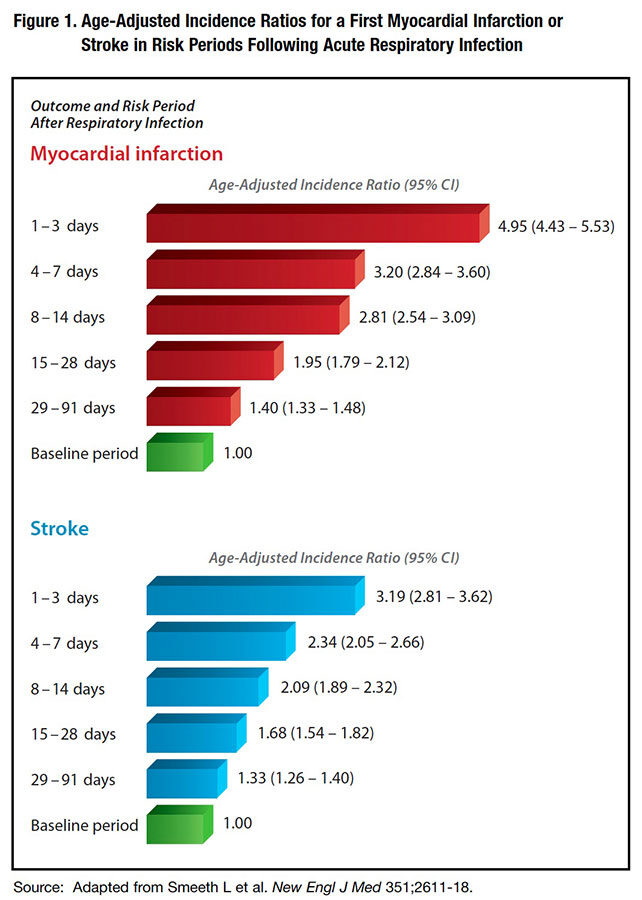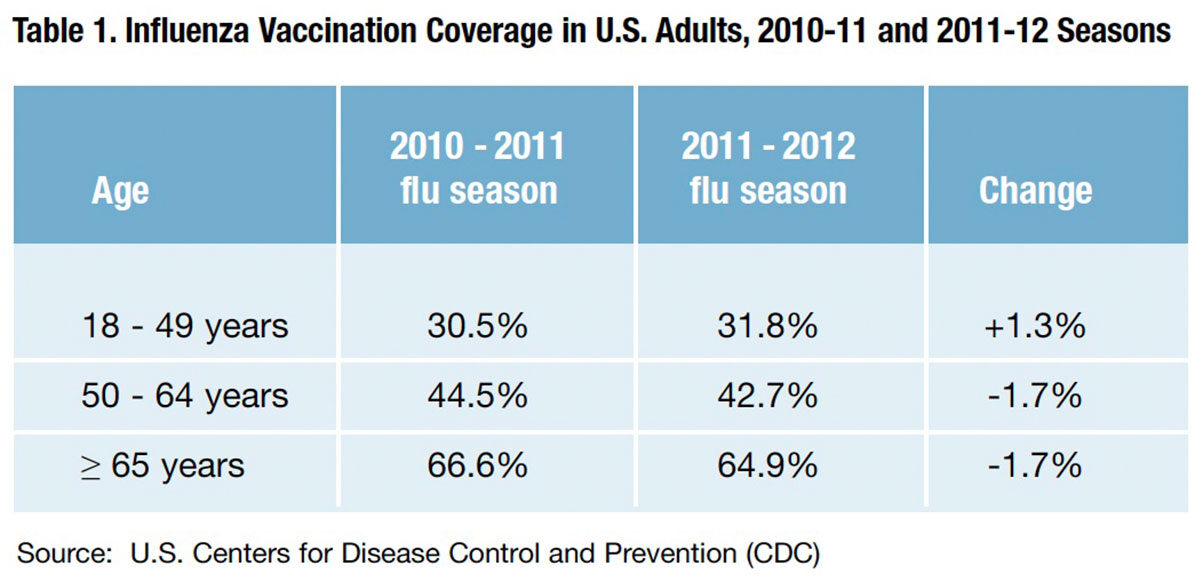The Heart of the Matter: A Flu Shot Could Save Your Life
- By Keith Berman, MPH, MBA
An ounce of prevention is worth a pound of cure.
— Benjamin Franklin
HOW MANY times have you asked a patient, friend or acquaintance if he or she got the annual flu shot yet, only to get some version of this reply: “No. Do I really need it?”
Earlier this year, I had that conversation with a 67-year-old New York City cab driver on my way out of town. Somehow, we got to chatting about news reports that influenza was hitting the area much harder than usual. “I got really sick with the flu two years ago,” he recalled. “I couldn’t get out of bed for almost two weeks. But now I’m stronger against it, so I don’t need a flu shot, right?”
While I tried my best to persuade this man to get his flu vaccine, I entirely forgot to pitch perhaps the most compelling reason of all: A flu shot could prevent a heart attack or even save his life. Thanks to a flurry of recent studies, it is now apparent that many thousands of people are walking around today because they took a few minutes to get a simple, inexpensive vaccination against seasonal influenza virus.
Flu, Cardiovascular Events and Death
A causal relationship between flu epidemics and increased death rates from nonrespiratory causes was first proposed more than 80 years ago.1 Decades later, a large 1994 population study estimated that roughly 20,000 excess deaths from cardiovascular disease occur each winter due to acute respiratory infections in England and Wales.2 Separate analyses of U.S. mortality data over a 40-year period also strongly suggested that excess wintertime deaths from acute ischemic heart disease and cerebrovascular disease can be directly attributed to influenza.3
The underlying link between influenza and fatal or nonfatal acute cardiovascular events isn’t entirely clear. The most widely proposed theory is that a spike in circulating levels of various inflammatory molecules that accompany flu infection can promote endothelial damage in the coronary and systemic vasculature, or destabilize atherosclerotic plaques, resulting in thrombosis. But other flu-related mechanisms may also play a role, including dehydration or the prothrombotic effects of bed rest during the illness.
Flu Vaccine as a “Heart Vaccine”
In 2004, a British research team examining the health records of 5.8 million adults reported sharply increased rates of both acute myocardial infarction (AMI) and stroke over the first 91 days following an acute respiratory tract infection (Figure 1).4 At that time, there were also concerns about potential risk of vascular events associated with the pro-inflammatory effects of vaccination. But the investigators found instead that influenza vaccination was associated with a significantly reduced risk of both AMI and stroke over several weeks following administration. By contrast, neither tetanus nor pneumococcal vaccinations had any influence on these event rates at all.

Subsequent studies have confirmed that a simple flu shot cuts the risk of AMI, particularly in older adults and those with known chronic cardiovascular disease. A 2010 study of the health records of nearly 79,000 unselected post-AMI patients aged 40 years and older found that influenza vaccination was associated with a 19 percent reduction in AMI risk. Further, patients vaccinated before mid-November had a lower risk of AMI than those vaccinated later in the flu season.5
A valid concern about retrospective studies like these is the potential for unintended bias. People who get a flu shot, or who get their vaccine early in the season, could happen also to embrace lifestyle behaviors that place them at lower risk for AMI or other serious cardiovascular events. But a very recent meta-analysis of four randomized controlled trials, collectively enrolling 3,227 patients with and without a history of cardiovascular disease, appears to put these questions to rest.6 In these generally older patients, whose average age was 60 years, influenza vaccine significantly reduced the one-year risk of major adverse cardiovascular events by nearly 50 percent (odds ratio [OR] 0.52; 95% confidence interval [CI] 0.37 to 0.74; p = 0.0002). In addition, there was a directionally consistent trend toward reduced cardiovascular death (OR 0.58; 95% CI 0.25 to 1.36; p = 0.21).
The Challenge: Connecting Patient and Vaccine
Whether due to lack of awareness, misconceptions about safety, needle-phobia or other factors, flu vaccination rates have plateaued (Table 1). Disappointingly, fewer than 40 percent of adults receive a flu vaccine, and only about two-thirds of adults are over age 65 years — whose high rates of coronary artery disease place them at highest risk for a cardiac event.7,8

Mainly through the U.S. Centers for Disease Control and Prevention, the word is getting out to the medical community that annual vaccination against the flu can protect against cardiac-related events.9,10 As always, it remains up to physicians and pharmacists to deliver this message and professional recommendation to their patients: Get your flu shot, get it as early as possible after it becomes available, and reduce your risk of heart attack and other potentially fatal acute vascular events.
References
- Collins S. Excess mortality from causes other than influenza and pneumonia during influenza epidemics. Public Health Reports 1932;47:2159-79.
- Woodhouse PR, Khaw KT, Plummer M, et al. Seasonal variations of plasma fibrinogen and factor VII activity in the elderly: winter infections and death from cardiovascular disease. Lancet 1994 Feb 19;343(8895):435-9.
- Reichert TA, Simonsen L, Sharma A, et al. Influenza and the winter increase in mortality in the United States. Am J Epidemiol 2004 Sep1;160(5):492-502.
- Smeeth L, Thomas SL, Hall AJ, et al. Risk of myocardial infarction and stroke after acute infection or vaccination. N Engl J Med 2004;351:2611-8.
- Siriwardena AN, Gwini SM, Coupland CA. Influenza vaccination, pneumococcal vaccination and risk of acute myocardial infarction: matched case-control study. CMAJ 2010 Oct 19;182(15):1617-23.
- Udell JA, Farkouh ME, Bhatt DL. Influenza vaccination and reduction of cardiovascular events — a systematic review and meta-analysis. Can J Cardiol 2012 Sep;28(5 Suppl): S161.
- Flu vaccination coverage, United States, 2011-12 influenza season. U.S. Centers for Disease Control and Prevention (CDC). Accessed February 20, 2013, at http://www.cdc.gov/flu/professionals/vaccination/coverage_1112estimates.htm#age-group.
- Final state-level influenza vaccination coverage estimates for the 2010-11 season, United States. Accessed atwww.cdc.gov/flu/professionals/vaccination/coverage_1011estimates.htm.
- Bresee J. Influenza: It’s not too late to vaccinate! (CDC Expert Commentary). Medscape News. Accessed February 20, 2013, at www.medscape.com/viewarticle/757344.
- Bridges C. Influenza and cardiac disease. QuantiaMD. Accessed February 20, 2013, at quantiamd.com/player /vcbrzszn?bc=1&par tner=cdc&m=111128_102468_cdc.